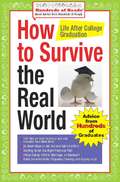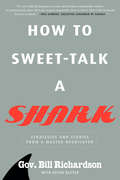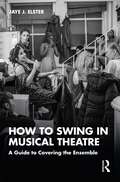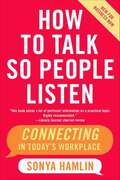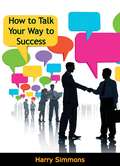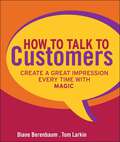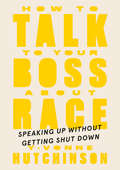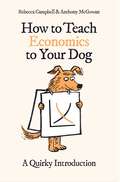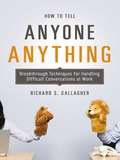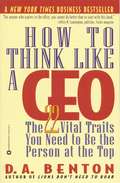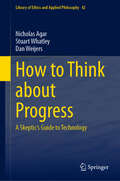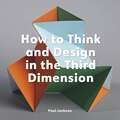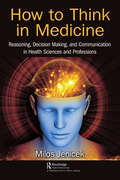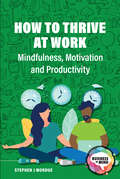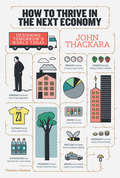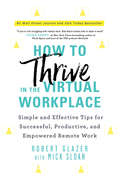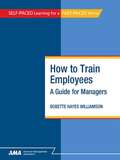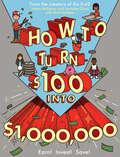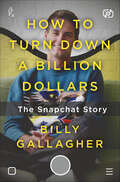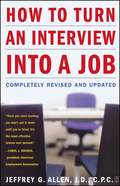- Table View
- List View
How to Survive the Real World: Life After College Graduation
by Andrea SyrtashAfter the parties, the frat rushes, the Big Test and the Big Game, the caffeinated all-nighters, and the pomp and circumstance, life comes knocking. Finding a job and keeping it; renting an apartment or sharing a sublet; dealing with your own money instead of your parents' money; looking for love (and looking and looking . . . ): who knew how complicated the world after college would be? Nearly 800 contributors to this How to Survive book found out, and happily share their hard-won insights. This useful, upbeat book collects stories, tips, and advice on finding the best place to live, entering adulthood without losing passion, taking care of one's health, finding a great job, and not going home for the holidays for the first time. Covering both the psychological adjustments and the nuts and bolts of daily life as a grown-up, How to Survive the Real World is witty, practical, and the perfect gift for the nervous grad.
How to Sweet-Talk a Shark: Strategies and Stories from a Master Negotiator
by Kevin Bleyer Bill RichardsonSharks are not evil. But they're single-minded and very, very hungry. On land, they take the form of bosses, businesspeople, colleagues, family, and sociopathic neighbors. In the world of former governor of New Mexico and US ambassador to the United Nations Bill Richardson, they have taken the form of the most powerful people in the world. He's engaged in high-stakes, face-to-face negotiations with Castro, Saddam, the Taliban, two generations of North Korean leadership, and many more of the world's most infamous dictators—and done it so well he was known as the "Undersecretary of Thugs" while with the Clinton administration. Now the 5-time Nobel Peace Prize nominee tells these stories—from Washington, DC, to the Middle East to Pyongyang—in all their intense and sometimes absurd glory.How to Sweet-Talk a Shark is a rare, candid, and entertaining glimpse into an insider's world of high-stakes negotiation—showing Richardson's successes and failures in some of the world's least friendly places. Meanwhile, readers get frank lessons in the art of negotiation: how to prepare, how to size up your opponent, how to understand the nature of power in a standoff, how to give up only what is necessary while getting what you want, and many other strategies Richardson has mastered through at-the-table experience—and from working with other master negotiators like Presidents Obama and Clinton, and Nelson Mandela. These are takeaways that anyone can use to negotiate with the power brokers, dealmakers, and, yes, the hungry sharks in their own lives.
How to Swing in Musical Theatre: A Guide to Covering the Ensemble
by Jaye J. ElsterHow to Swing in Musical Theatre shines a light on the most universal techniques used by cast members who, in response to absence, can perform multiple roles across an ensemble. This entertaining guide can be used not only to build a step-by-step understanding of what swinging is and how it can be approached, but also as a constant point of reference throughout a career in musical theatre. Providing a suite of practical, technical advice on everything from quick and easy notation to compiling one’s own personal swing ‘bible’, everything that an aspiring or experienced musical theatre performer will need is clearly arranged and thoughtfully explained. This book also teaches the SAFE Strategy, which is recognised as the most functional swing method and introduces the SAFE Principles of Swinging: Safety, Awareness, Function and Evolution. The principles are an original construct, devised to ward off stress and invite positive experience through reasoned behaviours. Musical theatre performers at every level of the profession will find this an invaluable guide that elevates their craft no matter what their previous training, experience or success in the industry.
How to Talk So People Listen: Connecting in Today's Workplace
by Sonya Hamlin“Provides thought-provoking insights and workable solutions to communicating with others in a changing world. . . . Highly recommended.” —Library Journal, starred reviewAt a time when it’s harder than ever to get and keep people’s attention, we could all use some help. Enter Sonya Hamlin, author of the now classic How to Talk So People Listen, and one of America’s leading communication experts. In this revised and updated edition, Hamlin shows us how to successfully capture people’s attention so that they listen, understand, and are persuaded by your message –– especially in the plugged–in, fast–paced, visually–driven atmosphere that is today’s workplace.Whether making a presentation to a large audience, dealing one–on–one with a client or colleague, or communicating by email, Hamlin teaches us that one of the keys to making people listen is to think about and respond to what motivates them—namely, self–interest. She then provides tools to assess others’ self–interest and use it to get them to listen to your message. Hamlin also explains how to capitalize on the latest visual aids we have at our disposal today. We learn to determine what information needs or lends itself to visual presentation, and how to make visuals active, so that they serve as an extension of the speaker. In How To Talk So People Listen, you’ll also find practical information on how to understand your audience, how to encourage your listeners to trust you, and how to be yourself when you’re on the podium.“A compendium of tested techniques that can help readers to improve communication on the job and elsewhere.” —Publishers Weekly
How to Talk Your Way to Success
by Harry SimmonsHave you ever stopped to think how much “talk” occurs in our own little busy world every day of our lives?Do you realize how much talk is involved in our jobs in everyday business? How everything we do every day of our lives involves conversation and speech on many different topics?Our conversations in our household and community affairs, at our desk in the office, out in the factory or on the road, with our fellow workers, executives, vendors, customers, visitors, friends—all these involve thousands of words every day in our lives.Imagine what help it might be to your prospects of success if all your talk and conversation were consciously directed to specific objectives and goals of accomplishment. Think of the pleasant and desirable things that might happen if your talks, your conversations, your letters, your telephone messages, your public appearances all were consciously channeled along the road to success.This book has as its major purpose the directing of all these words into proper, efficient, and effective lines of communication.
How to Talk to Customers: Create a Great Impression Every Time with MAGIC
by Tom Larkin Diane BerenbaumFilled with case studies and anecdotes, How to Talk to Customers demystifies the most critical aspect of customer service: conversations employees have every day with customers. In this must-have resource, Diane Berenbaum and Tom Larkin outline a proven system based on their MAGIC customer service training program. MAGIC, which stands for Make A Great Impression on the Customer, can help anyone become the type of communicator that makes their customers feel special. For more on this book, visit www.howtotalktocustomers.com
How to Talk to Your Boss About Race: Speaking Up Without Getting Shut Down
by Y-Vonne HutchinsonAn indispensable practical toolkit for dismantling racism in the workplace without fearReporting and personal testimonials have exposed racism in every institution in this country. But knowing that racism exists isn&’t nearly enough. Social media posts about #BlackLivesMatter are nice, but how do you push leadership towards real anti-racist action?Diversity and inclusion strategist Y-Vonne Hutchinson helps tech giants, political leaders, and Fortune 500 companies speak more productively about racism and bias and turn talk into action. In this clear and accessible guide, Hutchinson equips employees with a framework to think about race at work, prepares them to have frank and effective conversations with more powerful leaders, helps them center marginalized perspectives, and explains how to leverage power dynamics to get results while navigating backlash and gaslighting. How to Talk To Your Boss About Race is a crucial handbook to moving beyond fear to push for change. No matter how much formal power you have, you can create antiracist change at work.
How to Teach Economics to Your Dog: A Quirky Introduction
by Rebecca Campbell Anthony McGowanMonty is a dog, not a financial genius, but economics still shapes his everyday life. Over the course of seventeen walks, Dr Rebecca Campbell chews over economic concepts and investigates how they apply to our lives – people and mutts alike. There are no graphs, no charts (Monty can&’t read them) and definitely no calculus! How to Teach Economics to Your Dog tackles the knotty question of what economics actually is. Is it a mathematical science like physics? Or a moral and philosophical investigation of how societies should manage scarce resources? Along the way we meet some of the great thinkers from Adam Smith to Thomas Piketty, and ponder questions such as: What on earth does quantitative easing mean? And why are some countries so much richer than others?
How to Tell Anyone Anything: Breakthrough Techniques for Handling Difficult Conversations at Work
by Richard GallagherNo one likes to be criticized, but this book teaches the communication skills needed to successfully get the message across while keeping feelings and relationships intact.Drawing from the latest in psychology on how best to connect with others, How to Tell Anyone Anything steers you away from the common mistake of providing feedback by focusing on what&’s wrong and shows you instead how to provide clear, constructive positive messages that create real behavior and performance change.You&’ll learn how to:be more candid,prioritize relationships,ask important questions,reframe difficult messages,control your emotions,and be graceful when you&’re on the receiving end of difficult feedback.Complete with illuminating examples and a unique step-by-step process, How to Tell Anyone Anything gives you powerful insight into how we all react naturally to criticism--and how to transform interactions that might become verbal tugs-of-war into collaborative problem-solving sessions.
How to Think Deeply: A Brief Guide to Overcoming Your Depth Deficit
by Gerald Zaltman Lindsay ZaltmanThis chapter identifies a deficit in deep thinking among managers and discusses some factors contributing to this deficit, particularly managers' tendencies to overemphasize surface-level differences among consumers and to neglect the deep metaphors that enable us to observe such differences in the first place.
How to Think Like a CEO: The 22 Vital Traits You Need to Be the Person at the Top
by D. A. BentonDrawing on in-depth interviews with hundreds of the nation's top executives, D. A. Benton explains the 22 vital traits that make a CEO - the leader responsible for making decisions, guiding teams, selling ideas, managing crises, and conquering the mountains before them. You'll penetrate the mystery of why some people make it to the top and some don't, when they're all equally good at their jobs. You'll learn how to avoid getting fired and how to get promoted more quickly, how to enjoy the quality of life you want and deserve, and - if you decide you want to be the Big Boss - how to have the right character traits to get there. These are some of the traits that make a CEO. Are you ready to make them yours? You're gutsy and a little wild - yet modest and in control. You're competitive and tenacious - yet flexible and generous. You're willing to admit mistakes - yet unapologetic. You're secure in yourself - yet constantly improving. You're original and straightforward - yet think before you talk. Make your ascent not only gratifying, but also exhilarating and fun. This is how chiefs run the show - and how you can act like a chief to become a chief, even sooner than you dreamed.
How to Think about Information
by Dan SchillerIt is common wisdom that the U.S. economy has adapted to losses in its manufacturing base because of the booming information sector, with high-paying jobs for everything from wireless networks to video games. We are told we live in the Information Age, in which communications networks and media and information services drive the larger economy. While the Information Age may have looked sunny in the beginning, as it has developed it looks increasingly ominous: its economy and benefits grow more and more centralized--and in the United States, it has become less and less subject to democratic oversight. Corporations around the world have identified the value of information and are now seeking to control its production, transmission, and consumption. In How to Think about Information, Dan Schiller explores the ways information has been increasingly commodified as a result and how it both resembles and differs from other commodities. Through a linked series of theoretical, historical, and contemporary studies, Schiller reveals this commodification as both dynamic and expansionary, but also deeply conflicted and uncertain. He examines the transformative political and economic changes occurring throughout the informational realm and analyzes key dimensions of the process, including the buildup of new technological platforms, the growth of a transnationalizing culture industry, and the role played by China as it reinserts itself into an informationalized capitalism.
How to Think about Progress: A Skeptic's Guide to Technology (Library of Ethics and Applied Philosophy #42)
by Nicholas Agar Stuart Whatley Dan WeijersHow to Think about Progress is an interdisciplinary work exploring whether optimistic claims about technology’s potential stand up to humanity’s most difficult challenges. Will technology solve the problems of climate change, pandemics, cancer, loneliness, unhappiness, and even death? The authors show that techno-hype is all too often accepted because of the horizon bias, i.e. the modern propensity to believe that any problem that can be solved with technology will be solved in the very near future. The authors situate their analysis in a broad context, drawing on history, literature, and popular culture to emphasize their case against techno-hype. They also draw on a wide range of research, including that of biologists, philosophers of science and of language, psychologists, theorists of technological change, specialists on digital technologies, historians of ideas, and economists. As a corrective to much mainstream “futurism,” the book offers principles for seeing through much of the techno-hype that circulates online and in best-selling books. The authors share insights (without the jargon) from a variety of academic disciplines, making this book an engaging read for all audiences. Readers will find a balanced framework for thinking and writing about technological progress in the face of truly vexing challenges like cancer, climate change, and colonizing mars.
How to Think and Design in the Third Dimension
by Paul JacksonFrom paper folding genius Paul Jackson comes his latest book How to Think and Design in the Third Dimension. We live in a 3-D world, but most three-dimensional objects are designed from a series of two-dimensional side elevations and plan views. This book will teach you how to think and design in the third dimension. Through 60 construction projects, you will learn how folded paper units can be joined to create beautiful 3-D structures, according to the principles of three-dimensional symmetry. In addition to over 80 specially commissioned photographs and 300 step-by-step illustrations, this accessible book contains QR codes or hyperlinks to 30 short videos that show a selection of the projects rotating through 360 degrees.With How to Think and Design in the Third Dimension by their side, anyone who creates in three dimensions, including designers of all specialities, sculptors, architects, engineers and craftspeople, will be able to design with a new, practical and infinitely creative language of form.
How to Think and Design in the Third Dimension
by Paul JacksonFrom paper folding genius Paul Jackson comes his latest book How to Think and Design in the Third Dimension. We live in a 3-D world, but most three-dimensional objects are designed from a series of two-dimensional side elevations and plan views. This book will teach you how to think and design in the third dimension. Through 60 construction projects, you will learn how folded paper units can be joined to create beautiful 3-D structures, according to the principles of three-dimensional symmetry. In addition to over 80 specially commissioned photographs and 300 step-by-step illustrations, this accessible book contains QR codes or hyperlinks to 30 short videos that show a selection of the projects rotating through 360 degrees.With How to Think and Design in the Third Dimension by their side, anyone who creates in three dimensions, including designers of all specialities, sculptors, architects, engineers and craftspeople, will be able to design with a new, practical and infinitely creative language of form.
How to Think in Medicine: Reasoning, Decision Making, and Communication in Health Sciences and Professions
by Milos JenicekMastery of quality health care and patient safety begins as soon as we open the hospital doors for the first time and start acquiring practical experience. The acquisition of such experience includes much more than the development of sensorimotor skills and basic knowledge of sciences. It relies on effective reason, decision making, and communication shared by all health professionals, including physicians, nurses, dentists, pharmacists, and administrators. How to Think in Medicine, Reasoning, Decision Making, and Communications in Health Sciences is about these essential skills. It describes how physicians and health professionals reason, make decision, and practice medicine. Covering the basic considerations related to clinical and caregiver reasoning, it lays out a roadmap to help those new to health care as well as seasoned veterans overcome the complexities of working for the well-being of those who trust us with their physical and mental health. This book provides a step-by-step breakdown of the reasoning process for clinical work and clinical care. It examines both the general and medical ways of thinking, reasoning, argumentation, fact finding, and using evidence. It explores the principles of formal logic as applied to clinical problems and the use of evidence in logical reasoning. In addition to outline the fundamentals of decision making, it integrates coverage of clinical reasoning risk assessment, diagnosis, treatment, and prognosis in evidence-based medicine. Presented in four sections, this book discusses the history and position of the problem and the challenge of medical thinking; provides the philosophy interfacing topics of interest for health sciences professionals including the probabilities, uncertainties, risks, and other quantifications in health by steps of clinical work; decision making in clinical and community health care, research, and practice; Communication in clinical and community care including how to write medical articles, clinical case studies and case reporting, and oral and written communication in clinical and community practice and care.
How to Think: A Survival Guide for a World at Odds
by Alan Jacobs"Absolutely splendid . . . essential for understanding why there is so much bad thinking in political life right now." —David Brooks, New York TimesHow to Think is a contrarian treatise on why we’re not as good at thinking as we assume—but how recovering this lost art can rescue our inner lives from the chaos of modern life. As a celebrated cultural critic and a writer for national publications like The Atlantic and Harper’s, Alan Jacobs has spent his adult life belonging to communities that often clash in America’s culture wars. And in his years of confronting the big issues that divide us—political, social, religious—Jacobs has learned that many of our fiercest disputes occur not because we’re doomed to be divided, but because the people involved simply aren’t thinking. Most of us don’t want to think. Thinking is trouble. Thinking can force us out of familiar, comforting habits, and it can complicate our relationships with like-minded friends. Finally, thinking is slow, and that’s a problem when our habits of consuming information (mostly online) leave us lost in the spin cycle of social media, partisan bickering, and confirmation bias. In this smart, endlessly entertaining book, Jacobs diagnoses the many forces that act on us to prevent thinking—forces that have only worsened in the age of Twitter, “alternative facts,” and information overload—and he also dispels the many myths we hold about what it means to think well. (For example: It’s impossible to “think for yourself.”) Drawing on sources as far-flung as novelist Marilynne Robinson, basketball legend Wilt Chamberlain, British philosopher John Stuart Mill, and Christian theologian C.S. Lewis, Jacobs digs into the nuts and bolts of the cognitive process, offering hope that each of us can reclaim our mental lives from the impediments that plague us all. Because if we can learn to think together, maybe we can learn to live together, too.
How to Thrive at Work: Mindfulness, Motivation and Productivity (Business in Mind)
by Stephen J MordueAn essential read for anyone experiencing low level anxiety or stress, this book pulls together the various individual strands of business logic, scientific research, self-care, spirituality and common sense to provide a one-stop guide to thriving at work.The widespread ‘more for less’ attitude is creating a dramatic rise in work-related stress and a higher ratio of staff sickness. Not only does this create a fiscal impact upon the organisation and the broader economy but it has the potential to create significant long-term mental health issues for employees.You cannot always alter the demands of your professional or personal lives but, by understanding more about how your brain functions and by actively pursuing well-being techniques, you can enhance the skills that help you manage and succeed at the challenges thrown at you and reduce the risks associated with burnout.With a focus on improving mindfulness, motivation and productivity, this book offers sound, practical advice and strategies for self-care whatever your working environment and whatever stage you are at in your career.
How to Thrive in the Next Economy: Designing Tomorrow's World Today
by John ThackaraA visionary yet practical guide to building a more sustainable future, by one of the most important voices in environmentally aware design Are there practical solutions to the many global challenges—climate change, poverty, insufficient healthcare—that threaten our way of life? Author John Thackara has spent a lifetime roving the globe in search of design that serves human needs. In this clear-eyed but ultimately optimistic book, he argues that, in our eagerness to find big technological solutions, we have all too often ignored the astonishing creativity generated when people work together and in harmony with the world around them. Drawing on an inspiring range of examples, from a temple-led water management system in Bali that dates back hundreds of years to an innovative e-bike collective in Vienna, Thackara shows that below the radar of the mainstream media there are global communities creating a replacement economy—one that nurtures the earth and its inhabitants rather than jeopardizing its future—from the ground up. Each chapter is devoted to a concern all humans share—land and water management, housing, what we eat, what we wear, our health, how and why we travel—and demonstrates that it is possible to live a rich and fulfilling life based on stewardship rather than exploitation of the natural environment.
How to Thrive in the Virtual Workplace: Simple and Effective Tips for Successful, Productive, and Empowered Remote Work
by Robert GlazerThe remote work revolution has been rapidly accelerated by the COVID-19 pandemic. Organizations as big as Twitter have learned their employees didn't need an office to get great results, and employees are using the flexibility of remote work to live where they want, ditch their commutes and live a work-life integration that works for them.Remote work is here to stay, and the companies that do it well will have a clear competitive advantage in the future. As founder and CEO of Acceleration Partners, a 100 percent remote organization with 170 employees who work from home, Robert Glazer has discovered that with the right principles, tactics and tools for managing remote employees, many businesses can excel in a virtual world. In this highly actionable book, Glazer shares how he and his team built a remote organization that has been recognized with dozens of awards for its industry performance and company culture.How to Thrive in the Virtual Workplace shares insights from the remote employee, manager and leader perspectives, offering a blueprint any person can use to make remote work successful, productive and fulfilling. Learn how to leverage the flexibility of remote work, be more productive while working at home, avoid burnout, lead a team of virtual employees and build an organization that sets the gold standard for virtual work.The remote work revolution is here—the leaders who will build the future are the ones who can lead top performing virtual teams. Learn how to build a world-class organization—office no longer required.
How to Train Employees: A Guide for Managers
by Bobette Hayes WilliamsonAssess, design, deliver, and evaluate training that is right for every employee. As the global marketplace expands, the need for a flexible, well-trained workforce grows with it. Training employees to master business-critical skills has become a baseline requirement for managerial success. This book provides the tools and techniques to assess, design, deliver and evaluate training that is right for every employee. Based on a four-part training process, this book provides cases, exercises, worksheets and planning forms that make the learning immediate and dynamic and allow you to assemble the elements of your own training programs as you progress through the course. You will learn how to: • Link training to short-term job requirements and the strategic needs of the business • Collaborate effectively with training professionals before, during, and after training • Determine the training needs of your employees • Describe training objectives and measures • Design a training program and create and use lesson plans for dynamic instruction • Apply proven principles of adult learning throughout the training process • Present both on-the-job and classroom training • Support the transfer of learning from the training session back to the job • Evaluate the effectiveness of training
How to Turn $100 into $1,000,000: Earn! Save! Invest!
by James McKenna Jeannine Glista Matt FontaineFrom the creators of Biz Kid$ and Bill Nye the Science Guy, here is a comprehensive guide for kids to the basics of earning, saving, spending, and investing money. Written in a humorous but informative voice that engages young readers, it’s the book that every parent who wants to raise financially savvy and unspoiled children should buy for their kids. It is packed with lively illustrations to make difficult concepts easy to understand—all as a way of building financial literacy, good decision-making, and the appreciation of a hard-earned dollar.
How to Turn Down a Billion Dollars: The Snapchat Story
by Billy Gallagher"In the grand tradition of Ben Mezrich's The Accidental Billionaires (2009)... an engaging look into a fascinating subculture of millions." —Booklist"Breezy...How to Turn Down a Billion Dollars ably if uncritically chronicles the short history of a young company catering to young users, with a young chief executive, and reveals, intentionally or not, the limitations that come with that combination." —Wall Street JournalThe improbable and exhilarating story of the rise of Snapchat from a frat boy fantasy to a multi-billion dollar internet unicorn that has dramatically changed the way we communicate.In 2013 Evan Spiegel, the brash CEO of the social network Snapchat, and his co-founder Bobby Murphy stunned the press when they walked away from a three-billion-dollar offer from Facebook: how could an app teenagers use to text dirty photos dream of a higher valuation? Was this hubris, or genius? In How to Turn Down a Billion Dollars, tech journalist Billy Gallagher takes us inside the rise of one of Silicon Valley's hottest start-ups. Snapchat developed from a simple wish for disappearing pictures as Stanford junior Reggie Brown nursed regrets about photos he had sent. After an epic feud between best friends, Brown lost his stake in the company, while Spiegel has gone on to make a name for himself as a visionary—if ruthless—CEO worth billions, linked to celebrities like Taylor Swift and his wife, Miranda Kerr. A fellow Stanford undergrad and fraternity brother of the company’s founding trio, Gallagher has covered Snapchat from the start. He brings unique access to a company Bloomberg Business called “a cipher in the Silicon Valley technology community.” Gallagher offers insight into challenges Snapchat faces as it transitions from a playful app to one of the tech industry’s preeminent public companies. In the tradition of great business narratives, How to Turn Down a Billion Dollars offers the definitive account of a company whose goal is no less than to remake the future of entertainment.
How to Turn On the Charm: Building Influence Through Real Human Interactions for a Change
by Jeffrey PfefferThis chapter provides some important lessons in building and exercising influence by treating people with courtesy and respect.
How to Turn an Interview into a Job
by Jeffrey G. AllenA completely revised and updated edition of the bestselling, classic how-to on mastering the art of the interview Getting and winning the interview is the key to being hired. Everything else -- research, resumes, e-mails, phone calls -- is all backup for that crucial meeting. In How to Turn an Interview into a Job, America's leading interview authority, Jeffrey Allen, presents proven advice on the A to Zs of successful interviewing. Incorporating current etiquette and the new work ethic, Allen covers every step of the process, including: Making the initial phone calls Scheduling appointments Selecting an interview wardrobe How to have the toughest interviewer extend an offer The follow-up letter Maximum salary negotiation This new edition for the twenty-first century is also packed with ways to maximize current technology such as fax machines, voicemail, e-mail, and the Internet. For every kind of job seeker, How to Turn an Interview into a Job remains the simplest, most practical, and most streetwise guide to the fastest hire.
